«From Costa Volpino you go up to Volpino, then Corti, Branico, Qualino, Flaccanico…» says Riccardo Camanini at Identità Milano 2018. The destination is Ceratello, «141 inhabitants»; a land thus described: “It’s a land of pastures, fields, with chards and nice vineyards, and olive groves; and there are also forests, so that its inhabitants are mostly farmers, and shepherds. (…) In the forests there’s plenty of the most precious truffles” (Maironi Da Ponte, Dizionario Odeporico, Stamperia Mazzoleni, 1819). Ceratello, at 813 metres above sea level, was established centuries ago in a land rich in small water springs from the fields above.
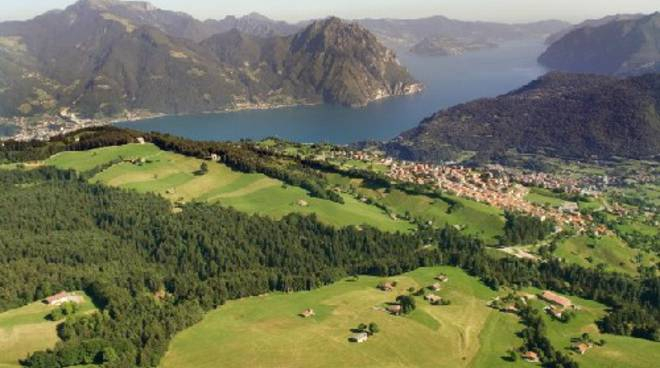
The plateau of Bossico with Lake Iseo in the background
This is
Camanini’s
Frittole: a place where time is suspended, or rewound. «Men have moustache this long», smiles the chef. Here he discovered a real, fairy tale humanity, crystallised in the preservation of its food tradition. But Ceratello is not the only place here, «the same applies to the Plateau of Bossico, a 10 minutes’ drive from Sovere, where I was born. It’s sunny all year round», continues the chef from
Lido 84. In these two places, Ceratello and Bossico,
Camanini has come across the surprising «
bernia, or
sbernia whatever you prefer», because Ceratello and Bossico have neighbouring fields, 9 km as the crow flies but there’s no road connecting them, they’re on the opposite side of Lake Iseo, so you have to go down, to the lake, and waste 40 minutes. Hence they use different words. This is the southern part of Val Camonica, in the province of Bergamo.
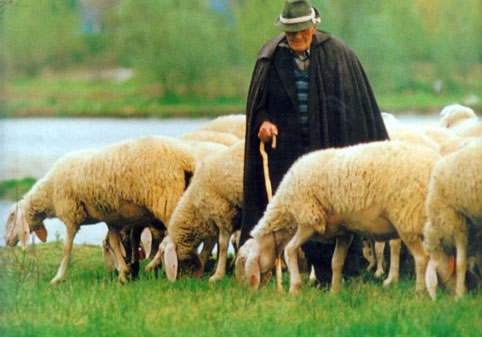
Pecora gigante bergamasca (photo Slow Food Bergamo)
According to an old etymological dictionary,
bernia, or
sbernia, is “
the ancient rough fabric that they used to make in Ireland (the ancient Hibèrnia), and the cloak made of it”, from the French
bornie,
berne. And indeed
Camanini was surprised to discover a sort of cloak, of coat, here. Yet made of meat, «shepherd’s meat» to be precise. Therefore nobody almost eats the gigante bergamasca sheep these days, and “it only survives thanks to the Arab world, because they buy it from local farmers. It’s not even a Slow Food Presidium and it doesn’t even appear in ancient recipes from Bergamo, unless in some recipes with mutton” (
Giulia Ubaldi,
Il Giornale del Cibo). A gradually abandoned food.
Yet it’s like fresh bread for
Camanini, who is thrilled to get the chance to venture in the lesser known culinary history of Italy, from Latin
Apicius (
What a lesson from Riccardo Camanini, chef of the yaer in 2017) to Renaissance
Bartolomeo Scappi (
Camanini and the origins of Italian cuisine), to this point, in the natural park of Alto Sebino, discussing traditions that have no written codification whatsoever and risk disappearing completely, a centennial wisdom lost in the hectic cauldron of modernity. But luckily we have him, a chef and anthropologist, almost.
So back to
bernia, or
sbernia. «I tasted it last year, for the first time. I had no idea of its existence until then». It’s the result of a shepherds’ tradition that intertwines economic needs with flavour, a typical Italian approach. It’s basically our very own response to poverty: limited economic resources sharpen our culinary wits, we make a virtue out of necessity, without forsaking flavour, «safeguarding aromas, and products». These recipes might be meagre, but are always tasty. «When a sheep got injured, there was no time or money to fix its legs. So they killed it». However, one had to preserve this precious source of proteins in the months to come. «They would cover it in wine and spices. Then they left it to dry in the open air for weeks, keeping insects away thanks to
moscarole, like very thick nets. It got dry. Later when shepherds would climb to the refuge, they’d cut a slice, now very hard, and chew it in the fields or grill it and serve it with polenta, or boil it, with onions and wild salad leaves». These flavours are very distant from what we’re used to these days, «our taste memory cannot recognise it. Even I found it hard to eat: too salty, very oxidised... The hanging influences the absorption and the release of liquids. The aroma is very strong».
So what does an (intelligent) contemporary chef do? He doesn’t try to imitate Spain or Northern Europe, nor does he remain set in our tradition, even when it has nothing to do with our days, as in this case. If a choice must be made, he takes tradition and presents a new take that can lead it into the future. This is what
Camanini does. «I tried to find a way to make
sbernia more balanced without changing its nature. It had to be made sweeter. I thought of honey, to make it gentler, but it wasn’t enough. Something more had to be done. One also needed something that would protect the meat during the hanging, a sort of protective cap».
The intuition – the use of honey – came during a recent trip to Sicily, when the chef «met the great
Corrado Assenza and a thousand more people.
Corrado introduced me to pure beeswax: it’s incredible, it tastes of propolis, of pollen».
But we’ll get there gradually. By pouring honey on the sheep, the latter extracts its flavour, in a sort of inverted osmosis. The honey protease also makes the meat softer, so that it doesn’t dry, «after three weeks, it’s as if the meat was fresh», plus the aroma of the honey becomes milder, more balanced. «I also asked artist Stefano Bombardieri for his help. We discussed the role of bees, their connection with the world of pastures. And we made use of their wax, an element about which Assenza had told me». Sbernia, now sticky because of the honey, is enclosed in a sort of “shield” made of beeswax, almost protected from the outside, its taste evolving in a both ancestral and innovative process.
Camanini now dips the gigante bergamasca sheep for 3 or 4 days in red wine, spices and herbs. Then he leaves it to dry for three weeks, at 800 or so metres above the sea level in Bossico and Ceratello, as customary. Then three more days in honey, and finally two weeks closed in its beeswax shield «but I believe it could stay there six months, I’m still trying» (for a one year’s old sheep, weighing 23 kilos, you need 3-4 kg of honey and 25 of beeswax). Now it’s as if the meat was reborn in its perfumed shield: just carve some wax and it’s underneath, red as blood, very soft. The chef touches it and it’s as if he was touching a fresh wound, a both sensual and striking image.
Camanini rewound the tape: the tape of history, rediscovering a traditional taste; the tape of nature, because he’s given new life, tone and flavour to something that was dead. Incredibly fascinating.
The outcome of this fairy tale process is a complete shepherd’s meal, made of four courses. First
Broth of sbernia: «I grill the dry parts of the shoulder to give them a smoky note. Then I make a broth (one litre of water every 2 kg of sbernia), and leave it to cool. It tastes like prosciutto, but it’s saltier and more aromatic»: it becomes an entrée with a few drops of oil aromatised with bay leaves’ extract.
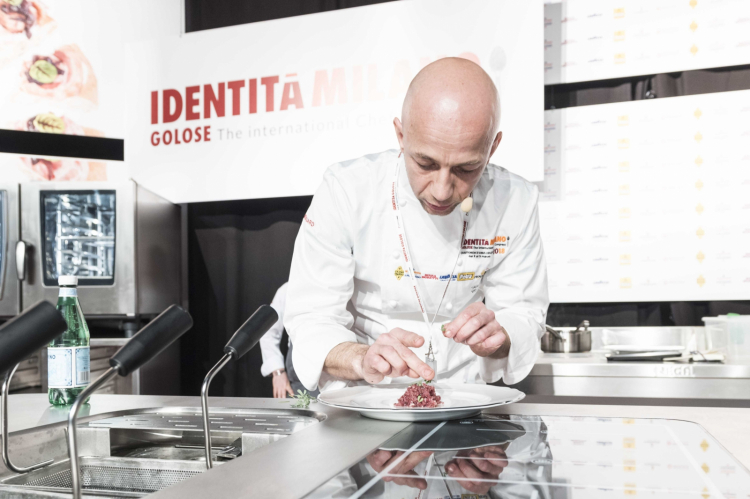
Sbernia steak tartare with rabbit kidneys and reduced chartreuse
Then
Sbernia steak tartare with rabbit kidneys and reduced chartreuse, let’s say it’s like a second starter. «The meat of the sheep has this aroma of honey and pollen, and it’s very soft. It’s already salty, you don’t need to add salt».
Camanini chops it finely, «it’s almost like homogenised meat», or else its flavour would be too strong and it would dry up your mouth. You need crunchiness, to give the dish a balanced texture, and fat to make it harmonious on the palate. The chef gets this result by using rabbit, which he roasts with rosemary, obtaining some fat («I like playing with fat "out of context”, as in the case of a beef bavette with pork lard») and uses its kidneys, which he almost toasts in the pan, «so they become crispy, almost like sweets». Finally, he adds erba ruta, a reduction of chartreuse giving a balsamic tone to match that of the sheep, and capers from Brescia to give a further salty note.
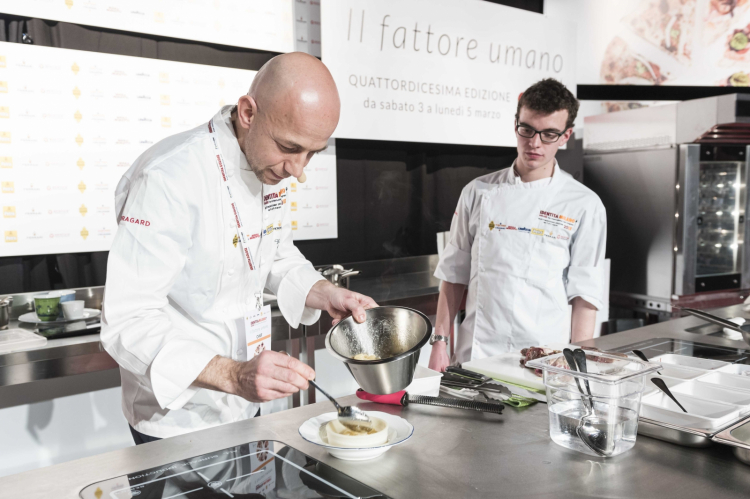
Pasta in bianco di sbernia
Then there’s
Pasta in bianco di sbernia: «I use durum wheat lumachine, an almost forgotten format, which is a pity». For the sauce, he uses some
sbernia, he processes it twice with seed oil, and puts it aside; then he processes the rabbit meat, and leaves it to rest so the watery part separates from the fat part. The result is an oil with a concentrated flavour which he uses to season the pasta. In this case,
Camanini goes against the grain, «I don’s serve it too al dente, because it must be thicker, it’s like a cuddle, soft. Plus shepherds would have never eaten it al dente, so I preserve the traditional idea». On top, he adds some grated cheese. Pecorino, of course.
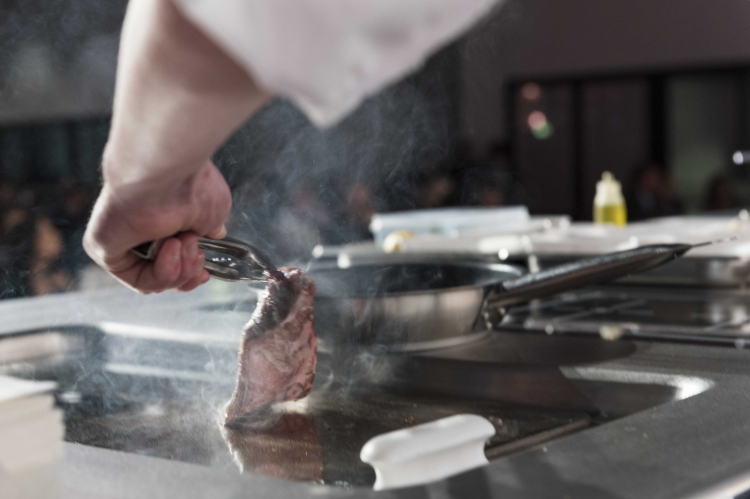
Grilling the Grilled sbernia leg with salad of wild herbs, helichrysum and bergamot honey, and extra virgin olive oil
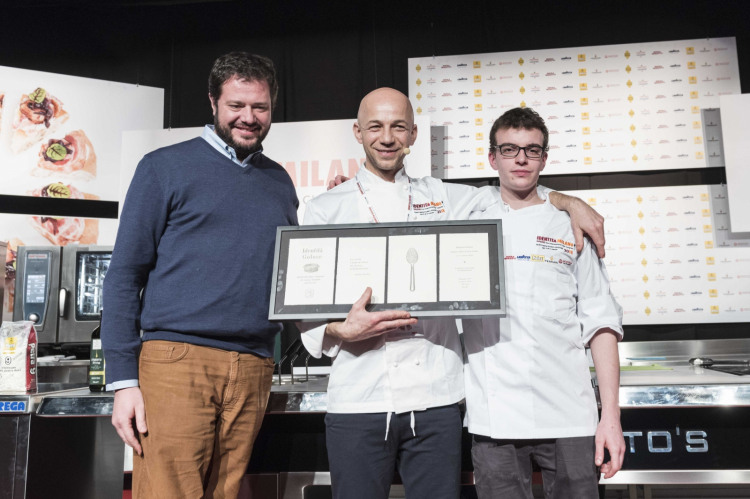
Camanini with his sous Gilles Fornoni and Marco Bolasco, who presented the lesson
Final dish,
Grilled sbernia leg with salad of wild herbs, helichrysum and bergamot honey, extra virgin olive oil. «I ate the “original”
sbernia. If grilled, it’s even drier and saltier». You cannot serve it, in other words. Yet the inverted osmosis due to the honey changes everything: «I intervened on tradition, so as to preserve it», chapeau. The meat, now soft and aromatic, is grilled on embers from olive wood, «it has an unusual taste, the meat is very mature. I make it gentler thanks to wild herbs, Indian mustard (despite its name, it’s originally from Bergamo!), salad leaves, but all woody, aromatic, balsamic. And then helichrysum honey – «it’s like rosemary, its scent reminds me of liquorice – and bergamot honey (was there the influence of
Assenza here too?) «which conveys a citric acidity but also preserves its bitter notes». On the grill, the meat is cooked rare, but it’s very mature. «A dish that thrilled me».
Translated into English by Slawka G. Scarso